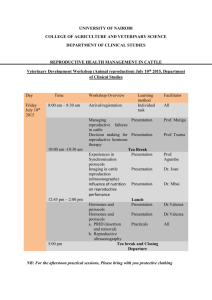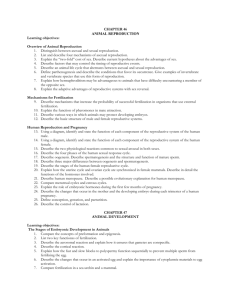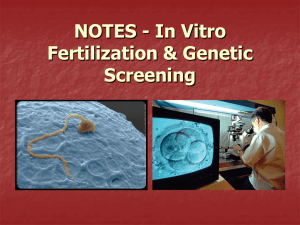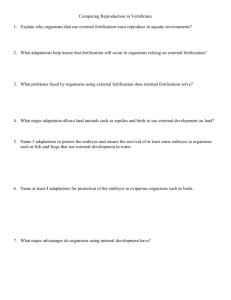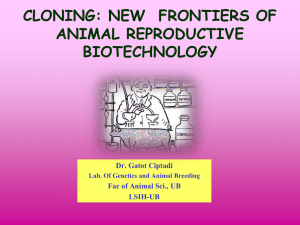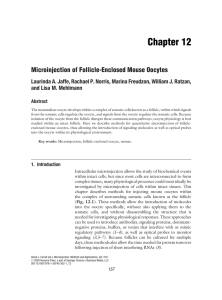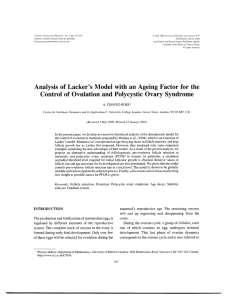IN VITRO FERTILIZATION IN BEEF CATTLE
advertisement
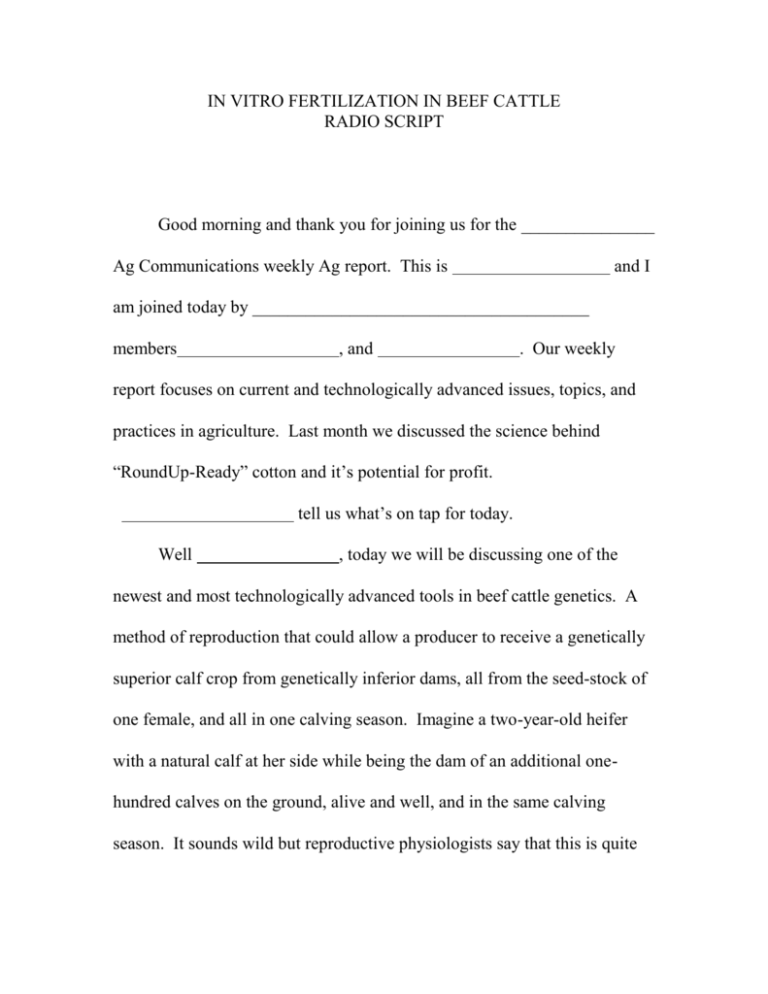
IN VITRO FERTILIZATION IN BEEF CATTLE RADIO SCRIPT Good morning and thank you for joining us for the _______________ Ag Communications weekly Ag report. This is and I am joined today by ______________________________________ members , and . Our weekly report focuses on current and technologically advanced issues, topics, and practices in agriculture. Last month we discussed the science behind “RoundUp-Ready” cotton and it’s potential for profit. tell us what’s on tap for today. Well , today we will be discussing one of the newest and most technologically advanced tools in beef cattle genetics. A method of reproduction that could allow a producer to receive a genetically superior calf crop from genetically inferior dams, all from the seed-stock of one female, and all in one calving season. Imagine a two-year-old heifer with a natural calf at her side while being the dam of an additional onehundred calves on the ground, alive and well, and in the same calving season. It sounds wild but reproductive physiologists say that this is quite possible with In Vitro Fertilization, and other recently developed techniques. Basically guys, In Vitro Fertilization allows one female to have multiple offspring in one calving season. This is accomplished by having a number of her fertilized eggs implanted into the reproductive tracts of surrogate mothers. Before we begin discussing In Vitro Fertilization let’s take a look back at some of the developments that led-up to it’s present day use. Embryo transfer, which was first used, is now old hat in the cattle industry, . At first, cows were super ovulated through various hormone injections and the resulting ova, or female sex cells, were collected surgically in a veterinary hospital and then transferred to recipient females for development. Next, non-surgical on the farm procedures were developed, and embryo transfer was used extensively. More recently, embryo splitting, freezing, sexing, and cloning have become options. Historically, embryo transfer has required that a donor cow be inseminated during her heat period, . The fertilized embryos were collected from the donor’s reproductive tract six to eight days later and then transferred to recipient females in the same stage of the reproductive cycle as the donor. This necessity for In Vivo, or in the living body insemination, was due to the inability of a sperm to fertilize an ova outside of the reproductive tract. However, scientists have perfected a procedure which gives sperm the capacity to fertilize eggs In Vitro, or outside the living body. This development greatly expands the possibilities of embryo transfer. A quick review of female reproductive physiology reveals that heifer calves produce viable oocytes, or unfertilized eggs, long before puberty and detectable heat periods . Oocytes develop inside follicles which appear on the ovaries. Several follicles appear on each ovary at the beginning of the reproductive cycle, which lasts eighteen to twenty-one days. Normally, one of these follicles becomes dominant and the others subside. This dominant follicle continues to develop, and after eighteen to twenty-one days the cow will come into standing heat, the follicle ruptures and releases the egg. However, if early in the cycle the follicles are removed, or are ruptured mechanically, the cycle starts over and , why don’t you tell us several new follicles form. about the actual oocyte collection procedure. Thank you . The In Vitro Fertilization or IVF procedure is non-surgical, does not require any hormone injections, and is said not to damage the female or her reproductive tract. A technician places an ultrasound-guided needle into the cow’s vagina. With his or her other hand placed in the rectum of the donor he or she holds the ovary against the ultrasound transducer and locates the follicles which contain the oocytes. The needle is then passed through the vaginal wall and into the follicle. The contents of the follicle are aspirated, or pulled out by a vacuum, and the egg is located microscopically in the laboratory. This procedure is repeated for each follicle. Removal of the follicles causes a new set of follicles to develop and the procedure can be repeated weekly. New follicles continue to develop for three to four months after pregnancy, and oocytes can be collected weekly during this period without disturbing the pregnancy. I will now turn the microphone over to who will tell us about the lab procedures. Well , once the oocytes are collected they must be cultured in a special media and incubated for about twenty four hours or until they are mature. The mature eggs are then placed in a fertilization media along with capacitated sperm for about eighteen hours. After fertilization occurs, the one celled egg must be cultured for seven to eight days before it will be suitable for transfer to the recipient cow, which will carry it to it’s full term. Dr. Bob Long, retired animal science professor in the College of Agriculture at Texas Tech University states that, currently, reproductive laboratories are reporting the ability to collect about six or seven oocytes per week with about thirty-five percent viability. The resulting pregnancy rate is about fifty percent, which makes it possible for about one pregnancy a week. However, as techniques improve IVF procedures will no doubt become more efficient, resulting in a tremendous increase in female reproduction potential. This increase in the number of offspring possible, plus the need for the elimination of hormone injection suggests that IVF will replace conventional embryo transfer procedures. IVF has the further advantage of being successful in obtaining embryos from cows where conventional methods have failed. Problem cows due to advanced age, abnormal reproductive tracts, and disease or failure to respond to hormone stimulation, have produced viable embryos by IVF. Top Terry County show-calf breeders, such as Steve Mason and Ricky Day could also find In Vitro Fertilization an economically feasible alternative to improving genetics in their herds. By purchasing frozen embryos from cattle breeders across the nation and implanting them in existing cows, they can avoid the high cost of expanding their herd while still achieving genetic superiority. Utah County Agricultural Extension Agent, Steve Bradshaw, reports five-thousand head of cattle on feed in Utah County, two-million-sixhundred-twenty-thousand head, on feed state-wide, and one-hundred-andforty-nine-thousand cattle producers in the State of Utah. Considering these numbers and their potential growth rate, In Vitro Fertilization could soon prove to be a wide-spread, economically beneficial procedure for genetic progress as technology and techniques improve. , before we go, I would like to remind all of our listeners that all transfer procedures are expensive and are probably not justified except with females that demonstrate truly superior and complete performance records. Likewise, even though IVF makes it possible to produce large numbers of offspring from very young heifers, such females have not established superiority and are therefore questionable candidates for beef improvement. Join us next time as we discuss farming techniques that utilize satellite technology, and in the future for more discussion over technologically advanced agricultural issues, topics, and practices. For the _______________________ Ag Communications class this is , and day and thank you for listening! , has a wonderful


